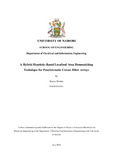| dc.description.abstract | Images have always been and remain a common and integral mode of human communication. In the 21st century, a two-pronged communications revolution in the form of mobile hand-held devices and social media has led to a higher reliance on visual communication through digital photographic images. A large portion of these digital images are captured through embedded cameras integrated in mobile devices. More so than in older stand-alone digital cameras.
To generate colour images while maintaining an affordable camera cost, a spectrally selective filter is placed on top of the raw data camera sensor. This filter termed a colour filter array, or CFA, subsamples colour data in a scene and a software-defined interpolation process termed demosaicking is performed later to fully reconstruct the image taken to make it more representative of the original scene. Many camera manufacturers employ the original array called the Bayer array. Recent studies, however, have shown that a newer array class referred to as panchromatic colour filter arrays possess superior light intensity properties and has a spectral selectivity distribution more in line with the human visual system than the prevalent Bayer array. This is an attractive property that can be exploited primarily in low to medium resolution integrated cameras that form a significant percentage of mobile device cameras.
Demosaicking is primarily biased to the Bayer array due to its prevalence. However, more and more manufacturers are beginning to explore alternatives to the Bayer array to improve image quality. This work presents a novel demosaicking algorithm for panchromatic arrays; in particular the RGBW panchromatic array class that is the most promising panchromatic array. The algorithm encodes light intensity information in a Bayerisation conversion process and uses combinatorial geometry, specifically polyominoes, to provide a novel adaptive weighting mechanism to reduce the introduction of visual artefacts during image interpolation. Interpolation is done in the ordinal directions and a variable plane relationship is established. A corrective mechanism is also introduced into the algorithm to improve image acuity.
Performance of the proposed demosaicking algorithm is objectively assessed using four documented image quality assessment metrics (MSE, CPSNR, SSIM and FSIMC) over five standard image sets (USC-SIPI, Kodak, McMaster-IMAX, Condat, ARRI) and one user-defined custom image set. Each set allows for the analysis of a unique property encountered in mobile device camera photography. This assessment is performed through simulation using the MATLAB® software platform. The algorithm results in a lowering of MSE by a factor of 1.6 and a rise in CPSNR by at least 2.49 dB in the RGBW domain. The algorithm also produces a robust SSIM and FSIMC profile with values greater than 0.98 in both measures. These improvements, noted through the aforementioned image assessment metrics, justify further adoption and study of the newer panchromatic class of arrays in integrated cameras. | en_US |

